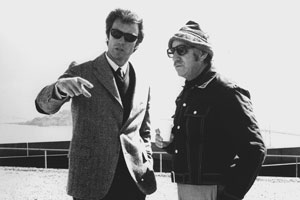 |
|
||
|
|||
Connections
How
Special Collections archival holdings tell the story of our time
Endless tales from the papers of Dirty Harry director
By Brian Fitzgerald
Harry Callahan knows that there is going to be hell to pay, and for good
reason. He has just executed the Scorpio serial killer with his .44-magnum
handgun at point- blank range -- after daring him to grab for his own
gun, which was on the ground.
|
|
|
| With San Francisco Bay in the background during location shooting, Don Siegel (right), producer-director of the movie Dirty Harry, listens to what Clint Eastwood has to say about the next scene. Photo courtesy of Warner Bros. | |
When Callahan hears the distant sound of police sirens, he takes his
detective's star out of his pocket, wondering if it's worth the trouble
to keep it. As he prepares to throw it into a pond, he suddenly changes
his mind and puts it back in his pocket.
However, as viewers of the 1971 movie Dirty Harry know full well, this
wasn't the ending. Callahan, played by Clint Eastwood, throws the badge
as far as he can into the water. That's the way producer and director
Don Siegel (1912-1991) wanted it. But Eastwood disagreed. Siegel, whose
papers and personal memorabilia are housed in BU's Special Collections,
writes in his autobiography, A Siegel Film, that Eastwood didn't want
to imply that his character -- even though he plays by his own rules --
was quitting the San Francisco Police Force by tossing his badge away.
"You're not quitting," said Siegel. "You're rejecting the
bureaucracy of the police department, which is characterized by adherence
to fixed rules and a hierarchy of authority."
"I still feel I'm quitting by throwing away my badge," said
Eastwood.
"You're wrong, Clint," responded Siegel. "You're rejecting
the stupidity of a system of administration, marked by officialdom and
red tape."
Even though he felt it wouldn't be as strong an ending, Siegel yielded
to Eastwood. Then, when preparing to shoot the scene, Eastwood changed
his mind. He wanted to throw the badge into the pond. The problem was
that because of Eastwood's earlier decision, only one badge was ordered.
What if they had to do a second take? The badge would be under water.
So Eastwood practiced by throwing stones the same size as his badge. And,
in case there was a reshoot, a large cloth was laid on the bottom of the
pond in the hope that someone could recover the badge. Fortunately, the
throw was perfectly executed.
Special Collections has some 50,000 items that Siegel donated, including
numerous screenplays, production notes, correspondence, and several manuscripts
of A Siegel Film, a book that reveals several suprising facts about Dirty
Harry. For example, Frank Sinatra originally agreed to star in the film,
but backed out because of a serious hand injury. And at one point, because
of disagreements with screenwriters, Siegel quit the project, only to
be coaxed back by Eastwood. "We have various drafts of Dirty Harry,
from the early stages to the shooting script," says J. C. Johnson
(COM'99), an archival assistant at Special Collections.
Siegel was one of the most respected directors of action films in Hollywood.
His 1956 film Invasion of the Body Snatchers, in spite of its low budget,
proved to be one of the most popular and profitable science fiction films
of the 1950s. In the late 1960s, Siegel began his association with Eastwood,
and his recognition rose with the actor's popularity after they made Two
Mules for Sister Sara, The Beguiled, and Play Misty for Me. His 1970s
films included John Wayne's final movie, The Shootist, and the Cold War
thriller Telefon.
Siegel didn't see eye-to-eye with many of his colleagues, but he was always
able to hammer out the details and produce the films under budget and
on schedule. Among the items in Special Collections are letters explaining
to writers and actors "his ideas for what should happen in the scripts
and his justification for these ideas," says Johnson. Despite the
sparring, verbal and in writing, he usually got his way.
One actor who wouldn't budge for Siegel, however, was John Wayne. Cranky
on the set of The Shootist and down to one lung after a bout with cancer,
Wayne made some major changes to the end of the script, including a moment
in which his character shoots a villain in the back. "I just don't
do that in movies," Wayne reportedly said, before demanding a reshoot
of the scene.
"We have several of Siegel's letters pertaining to the filming of
The Shootist," says Johnson. "After reading them, you soon realize
that even if you are the director, when you try to go against John Wayne's
wishes, you're going to be fighting an uphill battle. The papers provide
an interesting insight into the moviemaking process."
![]()
4 October 2002
Boston University
Office of University Relations
